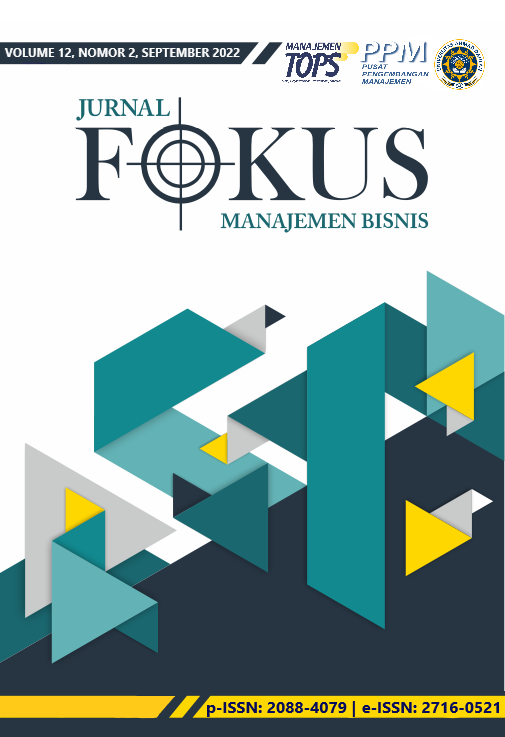PERBANDINGAN KINERJA KEUANGAN, STRUKTUR MODAL, DAN NILAI PERUSAHAAN PADA PERUSAHAAN KELUARGA DAN PERUSAHAAN NON-KELUARGA
DOI:
https://doi.org/10.12928/fokus.v12i2.6283Abstract
This study aims to determine the differences in the financial performance, capital structure, and firm value in family and non-family firms listed on the Indonesia Stock Exchange 2017-2019. The sampling method in this study used purposive sampling technique and data analysis used a pairwise sample methodology by comparing family and non-family firm. The results of this study indicate that there is no difference in finance performance as proxied by sales growth, sales, return on asset (ROA), return on equity (ROE), gross profit margin (GPM), net profit margin (NPM), but there are significant differences in total asset turn over (TATO). The capital structure also shows that there is no difference between the debt to total asset ratio (DAR) and the debt to total equity ratio (DER) proxy, but there is one significant proxy, namely pre-sales working capital and there is no difference in firm value as proxied by earning per share EPS between family and non-family firm.
References
Allouche, J., Amann, B., Jaussaud, J., & Kurashina, T. (2008). The Impact Of Family Control On The Performance And Financial Characteristics Of Family Versus Nonfamily Businesses In Japan: A Matched-Pair Investigation. Family Business Review, 21(4).
Andres, C. (2008). Large Shareholders And Firm Performance-An Empirical Examination Of Founding-Family Ownership. Journal of Corporate Finance, 14(4).
Black, F. (1996). The Dividend Puzzle. Journal of Portfolio Management, SUPPL.
Christian, A. R., & Sulistiyani, T. (2021). Pengantar Manajemen Bisnis - Google Books. Universitas Ahmad Dahlan PRESS.
Claessens, S., Djankov, S., & Lang, L. H. P. (2000). The Separation Of Ownership And Control In East Asian Corporations. Journal of Financial Economics, 58(1–2).
Darmawati, D., Khomsiyah, & Rahayu, R. . (2004). Hubungan Corporate Governance Dan Kinerja Perusahaan. Simposium Nasional Akuntansi (SNA) VII. Bali.
Goldberg, S. D. (1991). Factors Which Impact Effective Succession In Small Family-Owned Businesses: An Empirical Study. University of Massachusetts Amherst.
Gomez-Mejia, L. R., Nuñez-Nickel, M., & Gutierrez, I. (2001). The Role Of Family Ties In Agency Contracts. Academy of Management Journal, 44(1).
Granado-Peiró, N., & López-Gracia, J. (2017). Corporate Governance and Capital Structure: A Spanish Study. European Management Review, 14(1).
Harjito, D. A., Santoso, A. R. C., & McGowan, C. B. (2021). The Effect Of Corporate Governance And Corporate Strategy On Family Firm Performance In Indonesia. Journal of Applied Business Research, 37(1).
Hoopes, D. G., & Miller, D. (2006). Ownership Preferences, Competitive Heterogeneity, And Family-Controlled Businesses. Family Business Review, 19(2).
Houston, E. F. B. and J. F. (2019). Fundamentals of Financial Management, Fifteenth edition. In Cengage Learning, Inc.
Husnan, S. (2014). Manajemen Keuangan Teori dan Penerapan (Keputusan Jangka Panjang). In None.
Jenssen, J., Mishra, C., & Randoy, T. (2001). The Effects Of Family Influence On Firm Value And Corporate Governance: A Study Of Norwegian Firms. Journal of International Financial Management and Accounting, 12(3).
Kets de Vries, M. F. R. (1993). The Dynamics Of Family Controlled Firms: The Good And The Bad News. Organizational Dynamics, 21(3).
McConaughy, D. L., Walker, M. C., Henderson, G. V., & Mishra, C. S. (1998). Founding Family Controlled Firms: Efficiency And Value. Review of Financial Economics, 7(1).
Meckling, B. W. H. (1976). Values and the Choice of the Model of the Individual in the Social Sciences. Swiss Journal of Economics and Statistics (SJES), 112(IV).
Munawir, S. (2012). Analisis Informasi Keuangan. Liberty.
Niki, L. (2016). Corporate Governance Menuju Penguatan Konseptual Dan Implementasi di Indonesia. RN Hamidawati.
Nugroho, R. A., Pengestuti, I. D., & Sugiyono, S. (2017). Pengaruh Struktur Kepemilikan, Ukuran Perusahaan, Profitabilitas Dan Struktur Modal Terhadap Nilai Perusahaan Dengan Kebijakan Dividen Sebagai Variabel Intervening (Studi Empiris Perusahaan Manufaktur Yang Terdaftar Di Bursa Efek Indonesia Tahun 2011-2016. Diponegoro University.
Oswald, S. L., Muse, L. A., & Rutherford, M. W. (2009). The Influence Of Large Stake Family Control On Performance: Is It Agency Or Entrenchment? Journal of Small Business Management, 47(1).
Pratiwi, P. D., & Christian, A. R. (2021). Performa Keuangan Perusahaan Sub-Sektor terdampak Covid-19. INOBIS: Jurnal Inovasi Bisnis Dan Manajemen Indonesia, 5(1).
Santoso, A. R. C. (2020). Pengaruh Mekanisme Corporate Governance Terhadap Kinerja Keuangan Perusahaan Keluarga Di Indonesia. Jurnal Fokus Manajemen Bisnis, 10(1).
Schulze, W. S., Lubatkin, M. H., Dino, R. N., & Buchholtz, A. K. (2001). Agency Relationships in Family Firms: Theory and Evidence. Organization Science, 12(2).
Sonbay, Y. Y. (2022). Kritik Terhadap Pemberlakuan Teori Agensi Dalam Pengelolaan Dana Desa Di Suku Boti. Ekuitas (Jurnal Ekonomi Dan Keuangan), 6(2).
Sundana, I. M. (2011). Manajemen Keuangan Perusahaan.
Susilowati, I. H., & Sanjaya, Ip. S. (2016). Pengaruh Kepemilikan Ultimat Terhadap Keinformatifan Laba Pada Perusahaan Manufaktur Yang Terdaftar Di Bei. Modus, 27(1).
Wijaya, B. I., & Sedana, I. P. (2015). Pengaruh Profitabilitas Terhadap Nilai Perusahaan (Kebijakan Dividen Dan Kesempatan Investasi Sebagai Variabel Mediasi). Udayana University.
Wijayanti, L. (2013). Pengaruh Kontrol Keluarga dan Komisaris Independen terhadap Kebijakan Dividen dan Struktur Modal pada Perusahaan yang Terdaftar di BEI. Majalah Ekonomi Universitas Airlangga, 24(1).
Downloads
Published
How to Cite
Issue
Section
License
Copyright (c) 2022 Rai Rake Setyawan, Adhitya Rechandy Christian

This work is licensed under a Creative Commons Attribution-ShareAlike 4.0 International License.
Authors who publish with this journal agree to the following terms:Â
- Authors retain copyright and grant the journal right of first publication with the work simultaneously licensed under a Creative Commons Attribution License that allows others to share the work with an acknowledgment of the work's authorship and initial publication in this journal.
- Authors are able to enter into separate, additional contractual arrangements for the non-exclusive distribution of the journal's published version of the work (e.g., post it to an institutional repository or publish it in a book), with an acknowledgment of its initial publication in this journal.
- Authors are permitted and encouraged to post their work online (e.g., in institutional repositories or on their website) prior to and during the submission process, as it can lead to productive exchanges, as well as earlier and greater citation of published work (See The Effect of Open Access).







